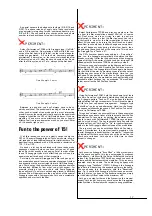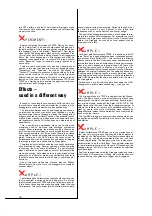
Contents
➤
Introduction
❯
First steps –
Listening to the Preset sounds and Demos . . 5
❯
At a glance . . . . . . . . . . . . 5
❯
Sound Organisation . . . . . . . . . 6
❯
Performance Storage and Management . . . 7
➤
Analogue
Workshop
❯
Sound Central – The Oscillator . . . . . . 9
❯
The Filters – Tastebuds for your Ears . . . . 10
❯
Dynamic Helpers – Envelopes . . . . . . 10
❯
Helper Motors – the LFOs. . . . . . . . 12
❯
About the Little Things . . . . . . . . 13
❯
Résumé . . . . . . . . . . . . . 14
➤
Arpeggiator –
A Box full of Tricks for all Occasions
❯
First Steps . . . . . . . . . . . . 16
❯
Sound Rhythm Tricks . . . . . . . . . 16
❯
Fun to the power of 15! . . . . . . . . 17
❯
Effects – used in a different way. . . . . . 18
❯
Hard Chord Work . . . . . . . . . . 18
❯
Keeping in line . . . . . . . . . . . 19
❯
Let‘s Groove! . . . . . . . . . . . . 20
➤
Performance Mode –
Practical Knowledge
❯
Scenes – what are they? . . . . . . . . 21
❯
Day to Day things . . . . . . . . . . 21
❯
Why Scenes? . . . . . . . . . . . 22
❯
The Effects . . . . . . . . . . . . 22
❯
Live Application . . . . . . . . . . . 24
❯
Split Performances . . . . . . . . . . 25
❯
Pulling out all the Stops . . . . . . . . 26
➤
Song Production: An Easy Start
❯
Songs in Performance Mode:
Six steps to success . . . . . . . . . 27
❯
The traditional approach:
Multi settings at the machine . . . . . . 28
➤
Song Production: The Basics
❯
What is “XG”? . . . . . . . . . . . 31
❯
Performance Mode or Multi Mode?. . . . . 31
❯
Where is the Multi Setup? . . . . . . . 32
❯
What is a “MIDI Event”? . . . . . . . . 32
❯
Decisions, decisions: Banks and Programs . . 33
❯
Who is controlling whom? . . . . . . . 34
❯
Everything under control: NPRN and RPN . . . 35
❯
Exclusive: Sys-Ex messages . . . . . . . 37
➤
Song Production:
More Tips and Tricks
❯
Part Mode and Drum Setups. . . . . . . 39
❯
Things worth knowing about the Variation Effect 39
❯
Still more Performances! . . . . . . . . 40
❯
Split Performances – used to great effect. . . 41
❯
Utility mode preparations . . . . . . . . 41
➤
Song Practice:
A View behind the Scenes
❯
Example 1: Sweep Run . . . . . . . . 43
❯
Example 2: “Blue Fuzz” . . . . . . . . 45
❯
Example 3: “Tekk it” . . . . . . . . . 46
➤
Appendix
❯
Summary of “Tutorial Disk” Files . . . . . 47
❯
Overview: “BLUE X-TRA” Disk Files . . . . 47
❯
The little Trouble Shooter. . . . . . . . 49
❯
Index . . . . . . . . . . . . . . 51



















